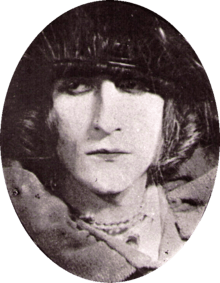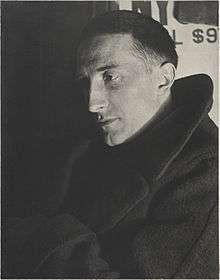Belle Haleine, Eau de Voilette
Belle Haleine, Eau de Voilette (Beautiful Breath, Veil Water) is a work of art by Marcel Duchamp, with the assistance of Man Ray. First conceived in 1920, created spring of 1921, Belle Haleine is one of the Readymades of Marcel Duchamp, or more specifically a rectified ready-made.[1][2]
%2C_Man_Ray%2C_1920-21%2C_Belle_Haleine%2C_Eau_de_Voilette.jpg)
A photograph of the object, by Man Ray, was reproduced on the cover of New York Dada magazine in April 1921.[3] This "readymade" consisted of a Rigaud brand perfume bottle with a modified label. It involved taking a mundane, utilitarian object, not generally considered to be art, and transforming it by adding a reworked label.[4]
In 2009, Belle Haleine, Eau de voilette became the most expensive Duchamp piece ever sold at auction when it brought in $11,500,000 (€8,913,000) at Christie's in Paris.[5][6] Previously, an artist's multiple of Duchamp's famed Fountain owned by Arturo Schwarz held the record, selling for $1,762,500 on November 17, 1999 at Sotheby's in New York.[7][8]
Overview

%2C_Man_Ray%2C_1920-21%2C_Belle_Haleine%2C_Eau_de_Voilette%2C_cover_of_New_York_Dada%2C_April_1921.jpg)
Duchamp removed the label from a Parfums Rigaud bottle, then proceeded, with Man Ray, to alter the object in several ways. The new label was specifically created by the two artists for the Rigaud bottle. For this reason Belle Haleine, Eau de Voilette is often referred to as an 'assisted readymade'.[1] The model on the label is Rrose Sélavy, an alter ego of Marcel Duchamp and one of his pseudonyms. Sélavy emerged in 1921, on this label, for the first time, though the name was first used to sign a readymade, Fresh Widow, in 1920.[1] Man Ray continued a series of photographs showing Duchamp dressed as a woman through the 1920s. Duchamp later used the name as the byline on written material and signed Rrose Sélavy on several works. The ambiguity of Duchamp in drag is not dissimilar to the image of the Mona Lisa with a goatee and mustache in Duchamp's L.H.O.O.Q. (1919). Mona Lisa became a man, and Duchamp became a woman.[1]
The original label on the Rigaud bottle read "Un air embaumé" (meaning perfumed air, or embalmed air), "Eau de Violette" (or Violet Water). By swapping positions of the "i" and "o" Duchamp and Man Ray obtained "Eau de Voilette" (meaning Veil Water). "Un air embaumé" was replaced with the unapologetic "Belle Halaine" (or "Beautiful Breath"). The "R" for Rigaud became "RS" for Rrose Sélavy.[1]
The object touches on several issues; authorship, since the label is by Rigaud, Duchamp and Man Ray; gender identity or sexual orientation, as the woman's perfume now has a Duchamp as its principle image. Further sexual connotations arise due to suggestions of smell, touch, and taste intrinsic to the piece.[1]
Shortly after its inception, Duchamp gave the bottle to Yvonne Chastel-Crotti, the ex-wife of Jean Crotti (who eventually married Suzanne Duchamp).[5] Yvonne Crotti kept it throughout her lifetime. The first exhibition within which Belle Haleine appeared was organized by the Cordier & Ekstrom Gallery, New York City, in 1965;[5] though a larger college version of the label was shown in 1930, at Galerie Goemans in Paris.[5][9]
References
- Belle Haleine eau de Voilette or Beautiful Breath: Veil Water, The Marcel Duchamp Studies Online Journal, tout fait.com
- Marcel Duchamp, L.H.O.O.Q. or La Joconde, 1964 (replica of 1919 original) Norton Simon Museum, Pasadena
- The Oxford Critical and Cultural History of Modernist Magazines, Volume III, Europe 1880 - 1940, p. 177
- Rudolf E. Kuenzli, Dada and Surrealist Film, MIT Press, 1996, p. 47, ISBN 026261121X
- Marcel Duchamp, Belle haleine - Eau de voilette, Collection Yves Saint Laurent et Pierre Bergé, Christie's Paris, Lot 37. 23 - 25 February 2009, Lot notes by Francis M. Naumann, November 2008
- Laurie Hurwitz, Saint Laurent Collection Soars at Christie's Paris. Duchamp's Belle haleine–Eau de Voilette, 1921
- Francis M. Naumann, The Art Defying the Art Market, Tout-fait: The Marcel Duchamp Studies Online Journal, vol. 2, 5, April 2003
- Carter B. Horsley, Contemporary Art & 14 Duchamp Readymades, The City Review, 2002
- Galerie Goemans, La peinture au défi: Exposition de collages, March 1930, catalogue p. 30, no. 9
Further reading
- M. Duchamp and M. Ray, in New York Dada, no. 1, 1921* R. Lebel, Sur Marcel Duchamp, Paris, 1959, p. 170, no. 149
- A. Schwarz, The Complete Works of Marcel Duchamp, Londres, 1969, p. 310, no. 123
- A. Schwarz, Documenti e periodici Dada, in Archivi d'arte del XX secolo, 1970
- A. Schwarz, Marcel Duchamp, 66 Creative Years from the First Painting to the Last Drawing, Paris, 1972, p. 40, no. 93
- Ubrigens Sterben immer die Anderen: Marcel Duchamp und die Avantgarde seit 1950, exhibition catalogue, Cologne, Museum Ludwig, 1988, p. 61
- M. Duchamp and E. Bonk, Marcel Duchamp, The Portable Museum, Londres, 1989, p. 247
- P. Hulten, J. Gough-Cooper and J. Caumont, Marcel Duchamp: Work and Life, Milan, 1993, p. 80
- F.M. Naumann, New York Dada, 1915-23, New York, 1994, pp. 52, 54
- B. Adams, The Age of Modernism: Art in the 20th century, exhibition catalogue, Berlin, The Martin-Gropius-Bau, 1997, p. 319
- A. Schwarz, The Complete Works of Marcel Duchamp, New York, 1997, vol. II, p. 688, no. 388
- B.J. Garner, "Duchamp Bottles Belle Greene: Just Desserts for his Canning", in Tout-Fait, no. 2, vol. 1, 2000
- S.J. Gould, "From the Bitter Negro Pun to the Beautiful Breath Bottle", in Tout-Fait, no. 2, vol. 1, 2000
- J. Mink, Duchamp 1887-1968: L'art contre l'art, Paris, 2001, p. 80
- B. Bailey, Duchamp's Chess Identity: 1917-1923, Cleveland, 2004, p. 107, no. 28* Saõ Paulo, Museu de Arte Moderna and Buenos Aires, Fundacion Proa, Marcel Duchamp: Uma obra que no uma obra "de arte", juin 2007-février 2009
External links
- Pierre Cabanne, Dialogues with Marcel Duchamp, New York, 1971, p. 64, full text online.
- Belle Haleine, Eau de Voilette (Beautiful Breath, Veil Water), Gelatin silver print, Philadelphia Museum of Art
